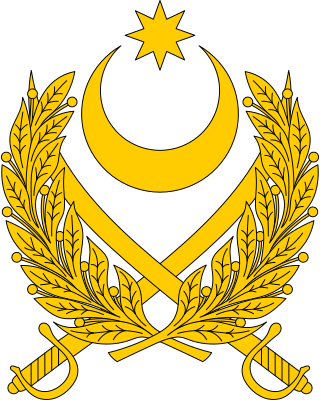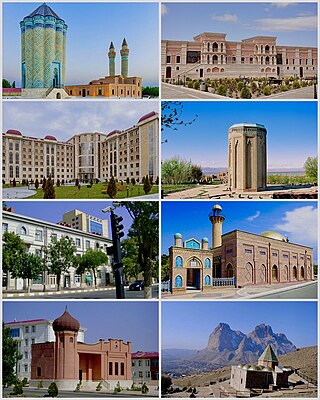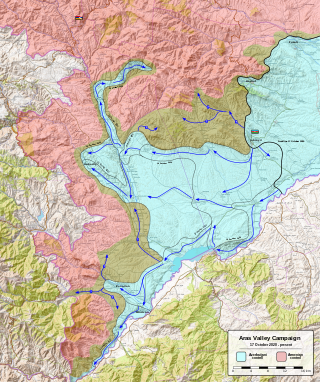
The Azerbaijani Armed Forces is the military of the Republic of Azerbaijan. It was re-established according to the country's Law of the Armed Forces on 9 October 1991. The original Azerbaijan Democratic Republic's armed forces were dissolved after Azerbaijan was absorbed into the Soviet Union as the Azerbaijan Soviet Socialist Republic from 28 April 1920. After the Soviet Union dissolved in 1991–92, Azerbaijan's armed forces were reformed based on Soviet bases and equipment left on Azerbaijani soil.

The Nakhchivan Autonomous Republic is a landlocked exclave of the Republic of Azerbaijan. The region covers 5,502.75 km2 (2,124.62 sq mi) with a population of 459,600. It is bordered by Armenia to the east and north, Iran to the southwest, and Turkey to the west. It is the sole autonomous republic of Azerbaijan, governed by its own elected legislature.

The Nakhichevan Autonomous Soviet Socialist Republic, abbreviated as Nakhichevan ASSR was an autonomous republic within the Azerbaijan SSR, itself a republic within the Soviet Union. It was formed on 16 March 1921 and became a part of the Azerbaijan SSR proper on 9 February 1924.

Khojavend District is one of the 66 districts of Azerbaijan. It is located in the west of the country and belongs to the Karabakh Economic Region. The district borders the districts of Lachin, Shusha, Khojaly, Aghdam, Aghjabadi, Fuzuli, Jabrayil, and Qubadli. Its capital and largest city is Khojavend. As of 2020, the district had a nominal population of 44,100.

Sadarak District is one of the 7 districts of the Nakhchivan Autonomous Republic of Azerbaijan. The district borders the district of Sharur, as well as the Iğdır Province of Turkey, Ararat Province of Armenia and the West Azerbaijan Province of Iran. Its capital is Heydarabad and largest settlement is Sadarak. As of 2020, the district had a population of 16,100.

Sharur District is one of the 7 districts of the Nakhchivan Autonomous Republic of Azerbaijan. The district borders the districts of Kangarli, Sadarak, as well as the Vayots Dzor and Ararat provinces of Armenia and the West Azerbaijan Province of Iran. Its capital and largest city is Sharur. As of 2020, the district had a population of 117,600.

Nakhchivan is the capital and largest city of the eponymous Nakhchivan Autonomous Republic, a true exclave of Azerbaijan, located 450 km (280 mi) west of Baku. The municipality of Nakhchivan consists of the city of Nakhchivan, the settlement of Əliabad and the villages of Başbaşı, Bulqan, Haciniyyət, Qaraçuq, Qaraxanbəyli, Tumbul, Qarağalıq, and Daşduz. It is spread over the foothills of Zangezur Mountains, on the right bank of the Nakhchivan River at an altitude of 873 m (2,864 ft) above sea level.

United Armenia, also known as Greater Armenia or Great Armenia, is an Armenian ethno-nationalist irredentist concept referring to areas within the traditional Armenian homeland—the Armenian Highland—which are currently or have historically been mostly populated by Armenians. The idea of what Armenians see as unification of their historical lands was prevalent throughout the 20th century and has been advocated by individuals, various organizations and institutions, including the nationalist parties Armenian Revolutionary Federation and Heritage, the ASALA and others.

The following outline is provided as an overview of and topical guide to Azerbaijan:
Şəybəy is a village situated in Jabrayil district of Azerbaijan, being placed on the left bank of Chaylag River 14 km east of the city of JabrayilAzerbaijan.
Günnüt is a village in the Sharur District of Nakhchivan Autonomous Republic, Azerbaijan. It is located in the right side of the Nakhchivan-Sadarak highway, 22 km away from the district center, on the plain.

Armenians had a historic presence in Nakhchivan. According to an Armenian tradition, Nakhchivan was founded by Noah, of the Abrahamic religions. During the Soviet era, Nakhchivan saw a significant demographic shift. The Armenian population saw a great reduction in their numbers throughout the years repatriating to Armenia. Nakhchivan's Armenian population gradually decreased to around 0%. Still some Armenian political groupings of Armenia and the Armenian diaspora, claim that Nakhchivan should belong to Armenia. The Medieval Armenian cemetery of Jugha (Julfa) in Nakhchivan, regarded by Armenians as the biggest and most precious repository of medieval headstones marked with Christian crosses – khachkars, was completely demolished by 2006.

The Nakhichevan uezd was a county (uezd) of the Erivan Governorate of the Caucasus Viceroyalty of the Russian Empire. It bordered the governorate's Sharur-Daralayaz uezd to the north, the Zangezur uezd of the Elizavetpol Governorate to the east, and Iran to the south. The uezd's administrative center was the city of Nakhichevan.

Zakir Asger oghlu Hasanov is an Azerbaijani politician and colonel general who has been the Minister of Defence of Azerbaijan since 2013.

The 2016 Nagorno-Karabakh conflict, also known as the Four-Day War, April War, or April clashes, began along the former Nagorno-Karabakh line of contact on 1 April 2016 with the Artsakh Defence Army, backed by the Armenian Armed Forces, on one side and the Azerbaijani Armed Forces on the other.

The Nakhchivan Garrison, also referred to as the Nakhchivan Army, formerly known as the 5th Army Corps, is a regional military formation of the Azerbaijani Armed Forces. The structures of all service branches and militarized institution in the territory of the Nakhchivan Autonomous Republic together form the Nakhchivan Garrison. It is currently led by Colonel General Karam Mustafayev.

Aras Valley campaign was a military operation launched by Azerbaijan against the breakaway Republic of Artsakh along the Aras River in the Azerbaijan–Iran border during the Second Nagorno-Karabakh War.

Karam Nariman oglu Mustafayev is an Azerbaijani military officer, colonel general serving as the deputy minister of defence of Azerbaijan and the commander of the Nakhchivan Garrison of the Azerbaijani Armed Forces.

The Muslim uprisings in Kars and Sharur–Nakhichevan were a series of insurgencies by local Muslims against the administration of the First Republic of Armenia, beginning on 1 July 1919 and ending 28 July 1920. The areas of uprising were persuaded into insurrection by the sedition of Turkish and Azerbaijani agents who were trying to destabilize Armenia in order to form a pan-Turkic corridor between their nations.


















